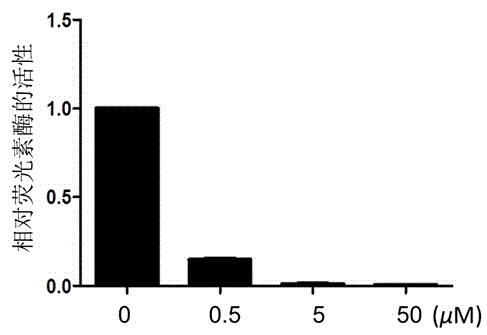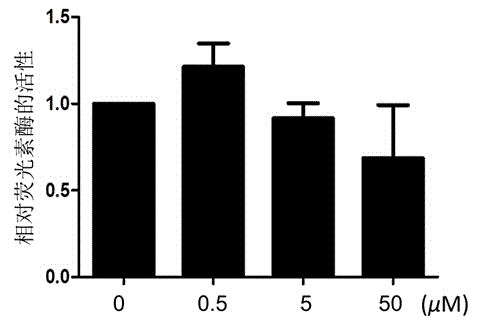Application of teicoplanin to resisting Ebola virus
A technology of Ebola virus and teicoplanin, applied in the direction of antiviral agents, glycopeptide components, etc., can solve the problem of lack of vaccines and drugs for Ebola virus, achieve good antiviral effect and avoid long-term failure Effect
- Summary
- Abstract
- Description
- Claims
- Application Information
AI Technical Summary
Problems solved by technology
Method used
Image
Examples
Embodiment 1
[0024] Example 1 The inhibitory effect of different concentrations of antibiotic teicoplanin on Ebola virus envelope protein GP
[0025] (1) Encapsulated virus: Transfect pHIV-luc, pCMV-deltaR8.2 and EBOV-GP plasmids into 293T cells (10cm dish), collect virus supernatant after 48 hours, and measure p24.
[0026] (2) Infection: 293T cells in a 96-well plate were infected with p24-normalized HIV-luc / EBOV-GP pseudotype virus containing 8ug / ml Polybrene, and different concentrations of the antibiotic teicoplanin were added at the same time.
[0027] (3) Change medium: 12 hours after infection, replace with fresh DMEM medium.
[0028] (4) Detection of luciferase activity: 48 hours after infection, wash each well once with PBS, then add 100ul lysis buffer, shake for 30min, take 10ul lysate to detect luciferase activity.
Embodiment 2
[0029] Example 2 The inhibitory effect of different concentrations of the antibiotic teicoplanin on the envelope of vesicular stomatitis virus VSV-G
[0030] (1) Packed virus: transfect pHIV-luc, pCMV-deltaR8.2 and VSV-G plasmids into 293T cells (10cm dish), and after 48 hours, collect the virus supernatant and measure p24.
[0031] (2) Infection: 293T cells in a 96-well plate were infected with p24-normalized HIV-luc / VSV-G pseudotype virus containing 8ug / ml Polybrene, and different concentrations of the antibiotic teicoplanin were added at the same time.
[0032] (3) Change medium: 12 hours after infection, replace with fresh DMEM medium.
[0033] (4) Detection of luciferase activity: 48 hours after infection, wash each well once with PBS, then add 100ul lysis buffer, shake for 30min, take 10ul lysate to detect luciferase activity.
[0034] According to the results of Example 1 and Example 2, the antibiotic teicoplanin can specifically act on the envelope protein EBOV-GP of ...
Embodiment 3
[0035] Example 3 Toxicity CC50 test
[0036] MTS (3-(4,5-dimethylthiazol-2-yl)-5(3-carboxymethoxyphenyl)-2-(4-sulfopheny)-2H-tetrazolium, inner salt) is a newly synthesized tetrazole with The application principle of MTT is the same, that is, it is reduced to colored formazan products by various dehydrogenases in the mitochondria of living cells, and its color depth is highly correlated with the number of living cells of some sensitive cell lines within a certain range. According to the measured absorbance value (OD value) at 490n, the number of viable cells is judged. The larger the OD value, the stronger the cell activity, and the less toxic the drug.
[0037] (1) Inoculate cells, use DMEM culture medium containing 10% fetal calf serum to prepare 293t into a single cell suspension, inoculate 1000 cells per well into a 96-well plate, and the volume of each well is 200ul
[0038] (2) Add the antibiotic teicoplanin after 24 hours of wall attachment, 2 μl per well, and the fina...
PUM
 Login to View More
Login to View More Abstract
Description
Claims
Application Information
 Login to View More
Login to View More - R&D
- Intellectual Property
- Life Sciences
- Materials
- Tech Scout
- Unparalleled Data Quality
- Higher Quality Content
- 60% Fewer Hallucinations
Browse by: Latest US Patents, China's latest patents, Technical Efficacy Thesaurus, Application Domain, Technology Topic, Popular Technical Reports.
© 2025 PatSnap. All rights reserved.Legal|Privacy policy|Modern Slavery Act Transparency Statement|Sitemap|About US| Contact US: help@patsnap.com



